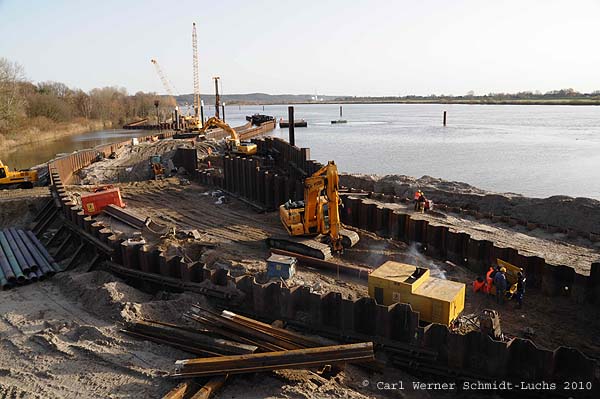| NLÖ 1990 :
In this area there is only one river bed building, the weir at Geesthacht (S1),
which is a very heavy impairment with very high removal effort. |
| |
 |
|
Personal
remark 06.04.2003:
The only obstacle in the german part of the river
Elbe. The river Elbe in this area is very broad. Within normal flow this
obstacle is only to be passed by big fishes. During a visit around pentcost 2003 a
seal was fishing in the entrance of the fishway. On an another visit in autuum
2003 I filmed a cormorant swallowing a very big silvereel, accompanied by
several fellows.
Migrationdevice : The former fishway did not work
because of to few current impulse and beeing situated in a bay without much
flow. Nowadays there is a broad roughened chute with high investment installed.
Surface migration downstream should be possible without problems. |
|
Actual april 2010 : more pictures of the construction
site you find here.
New March 2010 : Actually the new fishladder in
Geesthacht is beeing built (see photo on the right side).
Unusual are the dimensions of this double vertical slot fishway for the
common sturgeon (Ac. sturio): 16 x 10
meters ! Slotwidth 1,20 meter and 420 meters long - average baseslope 1:94.
Moreover the lower entrance of the fishway is directly beneath the obstacle
and not as more common in some distance to the obstacle. A
draft is found in the online part of the german "Bergedorfer Zeitung" of
friday, 13th march 2009. |
|
 |
| |
The entrance in the bottom water - a favourite
place for cormorants and
seals to prey on fishes . |
|

Middelpart of the rawbed raceway with a fitting dimension
compared to wide stream.

Functioncontrol:
Fix installed on the whole width of the chute. |

Outlet of the
roughened chute in the headwater of the
fishway. Another fishway on the other bank regarding the migration
requirements of the houting and the european smelt would not leave much wishes. Perhaps
one of the best devices in Germany especially in comparison to other streams
of similar broadness. Even bad swimmers like burbots, flounders and
stickelbacks were found during examination of the fishway.
|
|
|
|
|
|
|
|
|
|



